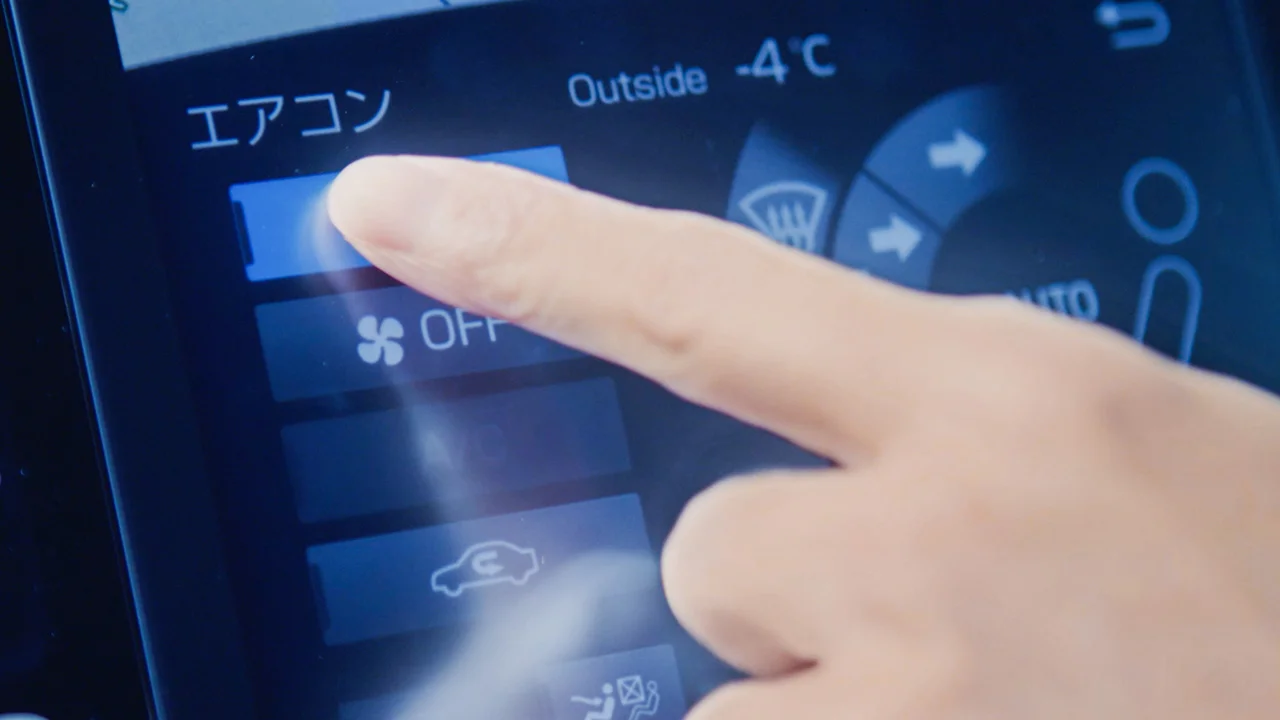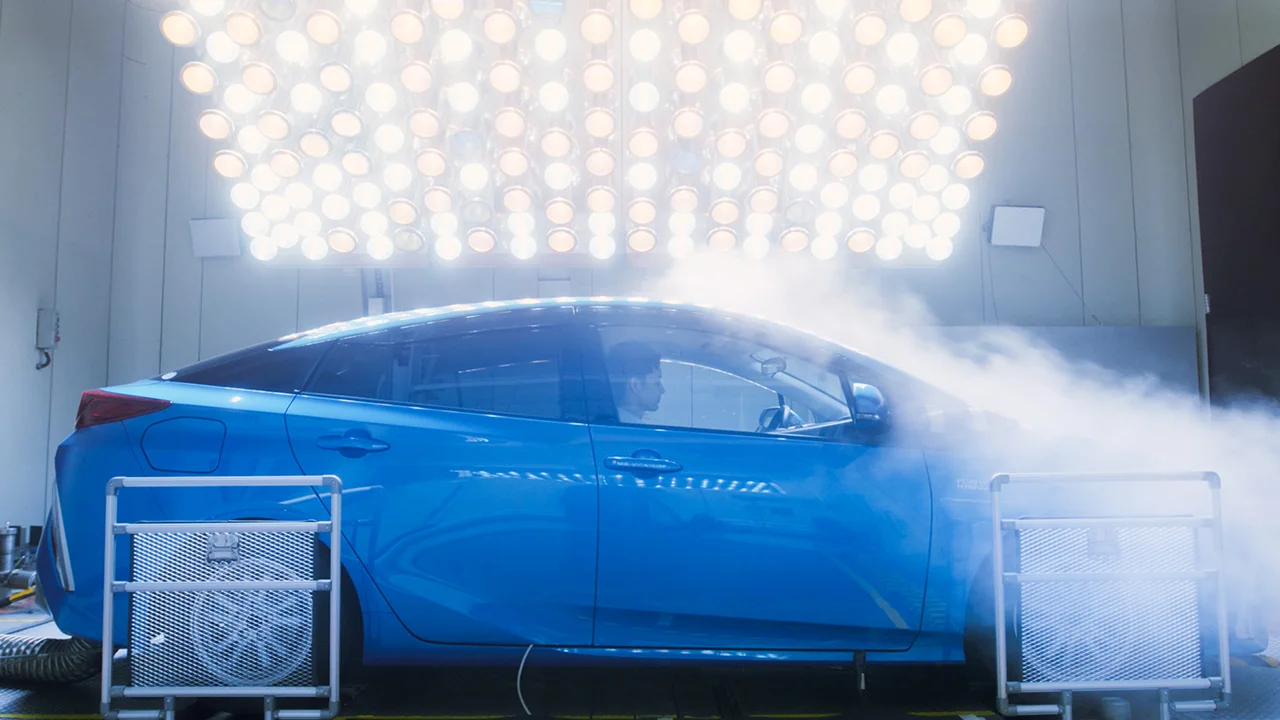

Jan 29, 2021
VISION & IDEAAutomotive air conditioning is the key to comfortable mobility
Heat management in electric vehicles for both comfort and freedom of movement
The earth’s population is estimated to reach ten billion by 2050, just a few decades from now. To enable such a large number of people to live comfortably, we must reduce our impact on the environment and make society more sustainable.
Many countries are already working on reducing CO2 emissions, including stepping up efforts to shift from standard engine-powered cars*1 to electric vehicles (EVs). However, when buying a car, most consumers are still concerned by the limited travel ranges*2of EVs compared with their engine-powered counterparts. But one technology—one we are all familiar with yet know surprisingly little about—could help eliminate this problem and extend EV travel ranges in comfort without increasing their impact on the environment.
*1 Engine-powered cars: Automobiles that are powered by a gasoline, diesel or other such engine.
*2 Travel range: The maximum distance a vehicle can travel on a full tank of fuel, or on a full battery charge in the case of an EV.
Contents of this article
Improving travel ranges and comfort with environmentally friendly EVs
Why do EVs have shorter travel ranges than engine-powered cars? One reason is that in many cars the electricity stored in the EV’s battery is used not only for moving the vehicle, but also for air conditioning.

In an engine-powered vehicle, the combustion of fuel produces the energy needed to move the car, and the heat released during this process is used by the cabin heating system as well. Since an EV has no engine, it does not have this heat source. This means that separate energy sources are required for movement and for heating, thereby increasing the energy requirement overall.
In winter, an EV equipped with an electric heating system consumes much more energy when using the heater compared to an engine-powered vehicle. This reduces the EV’s total travel range by up to 40 percent. Moreover, battery performance declines in cold weather while electric power consumption increases significantly. Driving is more popular during the colder months as people prefer to avoid cycling or switching trains in the cold. But given shorter travel ranges at low temperature, some drivers turn off the heater and put up with the cold in order to travel further.

Many drivers would like to be able to use an environmentally friendly EV in comfort all year round. There are two possible ways to do this: by providing another energy source for the heating system separate from that used for vehicle motive force, or by using the limited energy provided by the car’s battery more efficiently. An air conditioning system with a heat pump can achieve both of these.
Heat pump technology to achieve the EV goals of eco-friendliness and comfort
The air around us contains lots of thermal energy, and a heat pump harnesses this energy to heat the car’s interior via a medium known as a refrigerant*3, which conveys the heat from the outside air to the inside. The refrigerant is then compressed to make it hot, and used to heat the air inside the vehicle, which is blown into the cabin.
*3 Refrigerant: A heating medium used to transfer heat. The refrigerant in the heat pump becomes hotter when compressed and cooler when decompressed.
In this way, car air conditioning systems utilizing heat pump technology make use of air’s inherent heat energy, making an electric cabin heating system approximately three times more energy efficient. As a result, EVs with heat-pump-type heating systems can travel further than EVs with electric heating systems.
Creating a comfortable in-vehicle environment without affecting the outside environment
A wide range of weather and climate conditions must be taken into consideration when designing a heat-pump-based air conditioning system to create a truly comfortable cabin while efficiently using electricity.
Even in during the winter, the air still contains heat. However, less heat is available in the air overall when the temperature starts dipping below freezing. In addition, cold temperatures reduce the refrigerant density, which is needed by the heating system, and thus adversely affect system performance—this is one of the major engineering challenges of a heat pump system.

In the spring and fall the humidity rises and temperatures typically fluctuate. The air conditioning system must heat the cabin while preventing window fogging to ensure driving safety. However, large outdoor temperature fluctuations lower the performance of the heat pump, making the system less effective and prone to window fogging.
To overcome such problems, DENSO has been developing a heat pump that minimizes the electricity used by the heating system while also keeping the in-vehicle environment comfortable regardless of the outdoor temperature and humidity. In particular, we have been working to achieve longer travel distances when using this system even in cold weather, and have come up witha system that increases refrigerant density. With this system, the heat pump can be used to provide heating even with an outside temperature of –10°C (14°F). Furthermore, we are currently developing a system for EVs that is designed for colder environments, at temperatures as low as –20°C (–4°F).

DENSO has managed to eliminate excess humidity during heating, which is another major challenge faced by engineers, by using control technology that adapts to the specific conditions of the outside air from which thermal energy is captured. Using such technology, it is possible to enjoy comfortable in-vehicle temperatures, with no window fogging (to ensure driving safety), even in climates with high humidity and large temperature fluctuations. However, the system must be able to respond to constantly changing conditions throughout the journey, because factors such as ambient air humidity and direct sunlight affect the air conditioning system’s performance. Moreover, because the system blows air directly at the occupants from a very close distance compared with standard building and home systems, measures must be taken to prevent sudden changes to the temperature in the cabin. A heat-pump-based air conditioning system can respond to changes in outside air conditions and precisely control thermal energy factors in order to keep the in-vehicle temperature and humidity at the proper levels for consistent comfort.
Mitsuyoshi Saito, who works for DENSO’s Thermal Management Systems R&D Division, commented on the importance of in-vehicle comfort: “We consider cabin comfort our main goal. We want to develop vehicles that work in harmony with the environment without compromising on the vehicle users’ experience. To achieve this, we must find ways to reduce environmental impact while maintaining certain levels of comfort.”
Enabling longer travel ranges through Interlinked component operations
Just as smartphone batteries give off heat during use, EVs powered by electricity emit heat from their batteries and other components. DENSO’s heat pump system captures heat energy not only from the outside air, but also from inside the vehicle through interlinked operations with other components that generate heat. Capturing and using heat from these components improves heating-system efficiency and conserves more of the energy for powering the vehicle. Put simply, interlinked operations between the heat pump and other components extend travel distances without increasing the initial energy requirement.
An EV’s travel range is determined in part by the performance of the battery it uses to store electric energy. Batteries perform far less efficiently under hot and cold temperatures, while electricity consumption increases greatly, shortening the EV’s maximum travel range. Maintaining a stable battery temperature is vital to ensuring good battery performance. That’s why we have improved our heat pump system to enable monitoring and adjustment of battery temperature, thus keeping the battery at the optimal temperature. And because a heat-pump air conditioning system creates warm air for interior heating with approximately three times the energy efficiency of an electric heating system, even more energy is saved, preventing a drop in battery performance.
In short, DENSO’s heat pump system adjusts the battery temperature to ensure that it performs well under a wide range of ambient temperatures while minimizing unnecessary electricity consumption and significantly extending the range of the EV. Leveraging its comprehensive knowledge and experience in mobility technologies, DENSO has been developing its heat pump system to enable even greater travel distances without raising energy requirements, even in harsh climate and weather conditions.

Advances in EVs for an eco-friendly, people-friendly society
In developing heat pump systems, DENSO has cultivated sophisticated, fine-tuned thermal control technologies. Moreover, our experience in developing a wide range of vehicle parts has enabled the interlinking of operations between the heat pump and other EV components. Thanks to these thermal control technologies and our comprehensive experience with other vehicle components, we have increased the travel ranges of EVs while keeping them comfortable for passengers.
We envision eco-friendly EV travel that is kind to the earth and comfortable for people, regardless of the external temperature and humidity. By making EVs more comfortable, we’re taking a significant step closer to achieving a sustainable society.

REACTION
Changing your "Can'ts" into "Cans"
Where Knowledge and People Gather.




Leave a comment